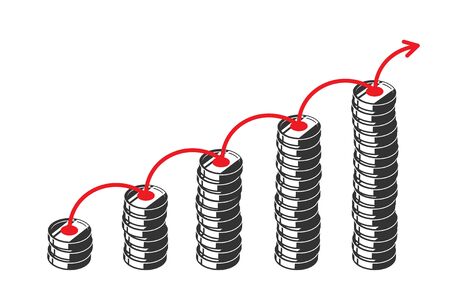1. Getting Started: Investing When Money Is Tight
If you’re living in the U.S. and thinking about investing but feel limited by your budget, you’re not alone. Many Americans start their investment journey with just a small amount of money. The good news? Today’s financial technology makes it easier than ever to get started, even if your funds are tight.
Adopting the Right Mindset
The first step is to shift your mindset. Investing isn’t just for the wealthy—anyone can start with even a few dollars. The key is consistency and patience. Think of investing as planting seeds; over time, those seeds can grow into something substantial, thanks to the power of compounding.
Essential Steps for First-Time Investors
- Set Clear Goals: Decide what you’re investing for (retirement, a house, or just building wealth).
- Start Small: Even $5 or $10 a week adds up over time.
- Learn the Basics: Understand terms like stocks, ETFs (exchange-traded funds), and diversification.
- Choose an Accessible Platform: Look for investment apps or online brokers with low minimums and no commissions.
- Prioritize Safety: Use reputable platforms protected by SIPC (Securities Investor Protection Corporation) insurance.
Popular Digital Tools for Small Investors
| App/Platform | Minimum Investment | Main Features | SIPC Protection |
|---|---|---|---|
| Robinhood | $0 | No commissions, easy-to-use interface, fractional shares | Yes |
| Acorns | $5 | Automatic round-ups from purchases, diversified ETF portfolios | Yes |
| Fidelity Investments | $0 | No account minimums, wide selection of stocks and ETFs | Yes |
| M1 Finance | $100 ($10 for retirement accounts) | Customizable portfolios (“pies”), automatic rebalancing | Yes |
Avoiding Common Pitfalls
Avoid “get rich quick” schemes or risky penny stocks. Stick to well-known companies and diversified ETFs when starting out. Remember: Slow and steady wins the race in long-term investing.
Your First Step Today
You don’t need thousands to begin—just determination and a willingness to learn. Set up an account with a trusted platform, deposit what you can afford, and make your first small investment. With time and discipline, your efforts will add up!
2. Stocks: Building a Portfolio with Fractional Shares
Investing in individual stocks has long been seen as a way to grow wealth, but for many beginners, the price of popular companies like Apple, Amazon, or Tesla can seem out of reach. That’s where fractional shares come into play, making it possible to own a piece of these big-name stocks—even if you only have a few dollars to spare.
What Are Fractional Shares?
Fractional shares are exactly what they sound like: instead of buying a full share of a company, you buy just a portion of one. For example, if one share of Amazon costs $120 and you invest $12, you’ll own 0.1 shares. Many major brokerage platforms in the U.S., such as Robinhood, Fidelity, Schwab, and SoFi, now offer this feature.
How Do Fractional Shares Help Investors With Limited Funds?
Fractional shares let you start investing right away without waiting until you save up hundreds of dollars for a single stock. You can diversify your investments by spreading small amounts across different companies or sectors. This flexibility helps beginners build confidence and learn about the stock market with less risk.
Pros and Cons of Investing in Fractional Shares
| Pros | Cons |
|---|---|
| Low minimum investment—start with just $1 | You may not receive voting rights as a partial shareholder |
| Diversify across many stocks easily | Not all brokerages offer fractional shares |
| Great for learning and building good habits early on | May be harder to transfer or sell outside your brokerage |
| Access to expensive “blue chip” stocks | Dividends are also paid out fractionally (smaller amounts) |
How to Get Started With Fractional Shares
Most major U.S. brokerages make it simple to get started:
- Create an account: Sign up with a brokerage that offers fractional shares.
- Add funds: Link your bank account and deposit any amount you’re comfortable with—even $5 is enough!
- Select your stocks: Search for the companies you love or want to learn more about. Enter the dollar amount you want to invest instead of choosing the number of shares.
- Review and buy: Confirm your purchase and watch your portfolio grow over time.
Cultural Note: The American Approach to Investing Small Amounts
The concept of “starting small” is widely embraced in American finance culture. With technology lowering barriers and apps making investing accessible to everyone, there’s never been a better time for beginners or those with limited budgets to get involved in the stock market. Whether you’re saving for retirement, a new car, or just want to dip your toes into investing, fractional shares can help turn those goals into reality—one dollar at a time.

3. ETFs: Diversifying on a Budget
If you’re just starting to invest and your funds are limited, Exchange-Traded Funds (ETFs) could be your best friend. ETFs let you buy into a wide range of stocks, bonds, or other assets all at once—making it easy to diversify without needing a lot of cash.
What Are ETFs?
ETFs are like baskets that hold dozens, hundreds, or even thousands of different investments. When you buy a single share of an ETF, you’re buying a tiny slice of everything in that basket. This helps lower the risk compared to putting all your money into one or two individual stocks.
Why Choose ETFs with Limited Funds?
- Instant Diversification: With just one purchase, you spread your risk across multiple companies or sectors.
- Lower Minimum Investment: Many brokers in the US allow you to buy fractional shares of ETFs, so you can get started with as little as $10 or $20.
- Low Fees: Most popular ETFs have very low management fees, often less than 0.1% per year.
- Easy to Trade: You can buy and sell ETFs anytime during market hours, just like stocks.
Popular ETF Types for Beginners
| ETF Type | Description | Example |
|---|---|---|
| S&P 500 ETF | Tracks the 500 largest US companies | SPY, VOO |
| Total Market ETF | Covers almost all publicly traded US stocks | VTI, SCHB |
| Bonds ETF | Invests in government or corporate bonds for stability | BND, AGG |
| Dividend ETF | Focuses on companies that pay regular dividends | VIG, SCHD |
| Thematic/Industry ETF | Covers specific industries like tech or healthcare | XLK (Tech), XLV (Healthcare) |
How to Get Started with ETFs in the US?
- Open a Brokerage Account: Choose a platform like Vanguard, Fidelity, Schwab, or Robinhood. Most have no account minimums and offer commission-free ETF trades.
- Select Your ETF(s): Start with broad-market ETFs for simple diversification.
- Decide Your Investment Amount: Many platforms allow fractional investing—so even if an ETF costs $400 per share, you can start with just $10.
- Buy Your Shares: Place your order and watch your investment grow over time!
If you’re looking to build wealth slowly and safely—even with limited funds—ETFs are a smart way to get started without feeling overwhelmed by stock picking or high entry costs.
4. Beyond Stocks and ETFs: Alternatives for Small Investors
If you’re just starting out or working with a tight budget, you might feel like your investing options are limited. But the U.S. market offers plenty of accessible alternatives beyond traditional stocks and ETFs. Let’s look at some practical ways to start investing, even with just a few dollars in your account.
Micro-Investing Apps
Micro-investing apps make it easy to invest small amounts—sometimes as little as $1 at a time. These platforms allow you to buy fractional shares of big companies, so you don’t need hundreds of dollars to get started. Popular options in the U.S. include:
| App Name | Key Features | Minimum Investment |
|---|---|---|
| Acorns | Automatically invests spare change from everyday purchases; offers diversified portfolios | No minimum (starts by rounding up purchases) |
| Stash | Fractional shares; educational tools for beginners; themed investment options | $5 |
| Robinhood | No commission fees; real-time trading; fractional shares available | $1 |
REITs (Real Estate Investment Trusts)
If you’ve ever wanted to invest in real estate but don’t have enough for a down payment, REITs are a great alternative. REITs let you pool your money with other investors to buy shares in commercial properties like malls, office buildings, or apartments. You can purchase publicly traded REITs through most brokerage accounts, often with no minimum investment.
Benefits of REITs for Small Investors:
- Low entry point compared to buying property directly
- Pays regular dividends (great for passive income seekers)
- Diversifies your portfolio beyond stocks and bonds
Robo-Advisors
If you prefer a hands-off approach, robo-advisors are automated investment platforms that build and manage a diversified portfolio for you. All you need to do is answer some questions about your financial goals and risk tolerance, and the platform does the rest.
| Robo-Advisor Name | Main Perks | Minimum Investment |
|---|---|---|
| Betterment | Automatic portfolio rebalancing; goal-based planning; low fees | No minimum for digital plan ($10 to start investing) |
| Wealthfront | Tax-loss harvesting; free financial planning tools; diversified portfolios | $500 |
| Sofi Invest Automated Investing | No management fees; automatic rebalancing; access to financial advisors | $1 |
Other Accessible Investment Options in the U.S.
- Bonds and Bond Funds: Many brokerages allow you to buy bond funds with low minimums, offering steady (though usually lower) returns.
- Crowdfunding Real Estate Platforms: Sites like Fundrise let you invest small amounts in private real estate projects.
- Savings & Certificate of Deposit (CD) Accounts: While not technically “investing,” high-yield savings accounts and CDs are safe places to grow your money when markets are rocky.
- Employer-Sponsored Retirement Plans: If your employer offers a 401(k) or similar plan—even small contributions can add up over time, especially if there’s a company match.
5. Tips for Growing Your Investments Over Time
Set Clear and Achievable Goals
Having a clear reason for investing helps you stay focused and motivated. Are you saving for a down payment, retirement, or just building wealth? Set specific goals, like “I want to save $5,000 in five years” or “I want my portfolio to grow by 7% each year.” Breaking your big goal into smaller milestones makes it easier to track your progress and stay on course.
Example of Setting Investment Goals
| Goal Type | Time Frame | How Much Needed |
|---|---|---|
| Emergency Fund | 1 year | $2,000 |
| Vacation Fund | 2 years | $3,000 |
| Retirement | 30+ years | $500,000+ |
Automate Your Contributions
The easiest way to build your investments is to set up automatic transfers from your checking account into your investment account. This way, you’re always investing—no need to remember or second-guess yourself. Even small amounts add up over time thanks to the power of compound growth. Many platforms let you automate as little as $25 per month.
Benefits of Automating Investments
- Makes saving and investing consistent and easy
- Reduces temptation to spend instead of invest
- Takes advantage of dollar-cost averaging (buying at various prices over time)
- Lowers stress by making investing a habit, not a chore
Minimize Fees Wherever Possible
Investment fees can eat away at your returns, especially if you have limited funds. Stick with low-fee index funds or ETFs, which often charge much less than actively managed mutual funds. Always check the expense ratios before investing. Some brokerages now offer commission-free trades for stocks and ETFs, so shop around for the best deal.
| Investment Type | Typical Fee Range (Expense Ratio) | Best For Limited Funds? |
|---|---|---|
| Index Funds/ETFs | 0.03% – 0.20% | Yes (low cost) |
| Mutual Funds (Active) | 0.75% – 1.50% | No (higher fees) |
| Individual Stocks (via apps) | $0/trade at some brokers | Yes (if commission-free) |
Create Positive Investing Habits for Long-Term Success
Your mindset matters as much as your money. Try these habits:
- Avoid chasing hot stocks: Focus on your plan, not market hype.
- Diversify: Don’t put all your eggs in one basket; spread your money across different assets like stocks, ETFs, and bonds.
- Review regularly: Check in on your investments every few months but avoid daily tracking that leads to panic selling.
- Keep learning: The more you know about investing basics and trends, the better decisions you’ll make.
- Stay patient: Investing is a marathon, not a sprint. Give your money time to grow.


